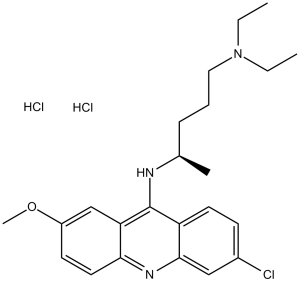Quinacrine 2HCl (Mepacrine; SN-390)
This product is for research use only, not for human use. We do not sell to patients.

For small sizes, please check our retail website as below: www.invivochem.com
| Size | Price | Stock |
|---|---|---|
| 1g | $150 | Check With Us |
| 10g | $450 | Check With Us |
| 20g | $675 | Check With Us |
Cat #: V1970 CAS #: 69-05-6 Purity ≥ 98%
Description: Quinacrine 2HCl (Mepacrine; SN-390) is a lipophilic cationic drug with multiple actions that is commonly used as an anti-protozoal agent.
Top Publications Citing Invivochem Products
Publications Citing InvivoChem Products
Product Promise

- Physicochemical and Storage Information
- Protocol
- Related Biological Data
- Stock Solution Preparation
- Quality Control Documentation
| Molecular Weight (MW) | 472.88 |
|---|---|
| Molecular Formula | C23H30ClN3O.2HCl |
| CAS No. | 69-05-6 |
| Storage | -20℃ for 3 years in powder formr |
| -80℃ for 2 years in solvent | |
| Solubility In Vitro | DMSO: 14 mg/mL (29.6 mM)r |
| Water: 53 mg/mL (112.1 mM)r | |
| Ethanol: 28 mg/mL (59.2 mM) | |
| SMILES Code | CC(NC1=C(C=C(OC)C=C2)C2=NC3=CC(Cl)=CC=C31)CCCN(CC)CC.[H]Cl.[H]Cl |
| Synonyms | SN 390; SN-390; SN390; ST 439; AI3-04467; ST439; AI304467; Acrichine; Acrinamine; Acriquine; mepacrine dihydrochoride; atabrine. |
| Protocol | In Vitro | Quinacrine (15 μM; 24 hours) treatment significantly increased the levels of proapoptotic proteins, including cytochrome c, Bax, and p53, and decreased the levels of antiapoptotic protein Bcl-2, thus shifting the ratio of Bax/Bcl-2 in favor of apoptosis. Quinacrine (7.5 and 15 μM; 24 hours) induces apoptosis in SGC-7901 cells, which is associated with mitochondria-dependent signal pathway and involves p53 upregulation and caspase-3 activation pathway. Quinacrine (5-20 μM; 24 hours) inhibits the growth of SGC-7901 cells. |
|---|---|---|
| In Vivo | Quinacrine (100 mg/kg three times per week for two consecutive weeks) significantly suppresses circulating blast cells at days 30/31 and increases the median survival time (MST). Quinacrine does not decrease the body weight of treated animals at the tested dose. |
These protocols are for reference only. InvivoChem does not
independently validate these methods.
| Solvent volume to be added | Mass (the weight of a compound) | |||
|---|---|---|---|---|
| Mother liquor concentration | 1mg | 5mg | 10mg | 20mg |
| 1mM | 2.1147 mL | 10.5735 mL | 21.1470 mL | 42.2940 mL |
| 5mM | 0.4229 mL | 2.1147 mL | 4.2294 mL | 8.4588 mL |
| 10mM | 0.2115 mL | 1.0574 mL | 2.1147 mL | 4.2294 mL |
| 20mM | 0.1057 mL | 0.5287 mL | 1.0574 mL | 2.1147 mL |
The molarity calculator equation
Mass(g) = Concentration(mol/L) × Volume(L) × Molecular Weight(g/mol)
Mass
=
Concentration
×
Volume
×
Molecular Weight*
The dilution calculator equation
Concentration(start)
×
Volume(start)
=
Concentration(final)
×
Volume(final)
This equation is commonly abbreviated as: C1 V1 = C2 V2
Concentration(start)
C1
×
Volume(start)
V1
=
Concentration(final)
C2
×
Volume(final)
V2
Step One: Enter information below
Dosage mg/kg
Average weight of animals g
Dosing volume per animal µL
Number of animals
Step Two: Enter the in vivo formulation
%DMSO
+
%
+
%Tween 80
+
%ddH2O
Calculation Results:
Working concentration:
mg/ml;
Method for preparing DMSO master liquid:
mg
drug pre-dissolved in
µL
DMSO(Master liquid concentration
mg/mL)
,Please contact us first if the concentration exceeds the DMSO solubility of the batch of drug.
Method for preparing in vivo formulation:
Take
µL
DMSO master liquid, next add
µL
PEG300, mix and clarify, next add
µL
Tween 80,mix and clarify, next add
µL
ddH2O,mix and clarify.
Note:
- (1) Please be sure that the solution is clear before the addition of next solvent. Dissolution methods like vortex, ultrasound or warming and heat may be used to aid dissolving.
- (2) Be sure to add the solvent(s) in order.




































